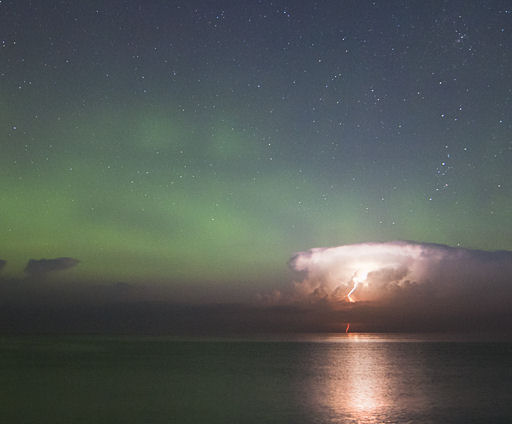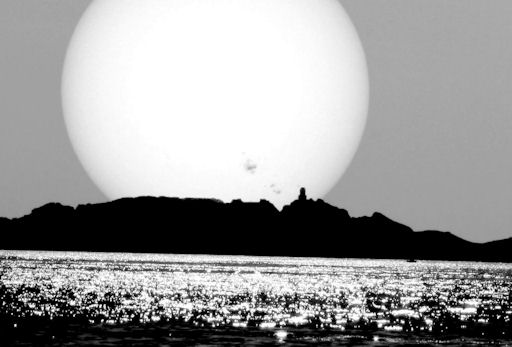ELECTRIC AURORAS: Earth's magnetic field is still reverberating from the CME strike of July 14th. This morning, July 17th, at 1:00 am CDT, Shawn Malone witnessed one of the aftershocks over Lake Superior:
"My dog hates lightning and awoke me at 1am," says Malone. "I caught a double light show: an isolated thunderstorm moving across Lake Superior plus the bright glow of the Northern Lights above the clouds, awesome!"
The odds of more auroras tonight are low as the geomagnetic field continues to settle down. During the peak of the display on July 14th through 16th, Northern Lights appeared in the United States as far south as Oregon, California, Colorado, Missouri, Utah, Wisconsin, Iowa, Minnesota, Wyoming, Washington, Illinois, Kansas, South Dakota, Nebraska, Michigan and Arkansas. Visit our aurora gallery for a complete set of images:
THE SOURCE OF THE DISPLAY: Big sunspot AR1520, the source of the X-flare that instigated this weekend's auroras, can attract observers even without exploding. During a quiet moment yesterday in France, it showed itself at sunset:
Photographer VegaStar Carpentier took the picture on July 15th overlooking an island near the Coast of Marseilles.
The behemoth sunspot has a beta-gamma-delta magnetic field that harbors energy for more X-class solar flares. The odds of a geoeffective eruption are decreasing, however, as the sunspot turns toward Earth. NOAA forecasters estimate a 40% chance of M-flares and a 15% chance of X-flares during the next 24 hours. Solar flare alerts: text, voice.

![]()
Solar wind
speed: 475.5 km/sec
density: 0.9 protons/cm3
explanation | more data
Updated: Today at 1447 UT
![]()
X-ray Solar Flares
6-hr max: C3 1400 UT Jul17
24-hr: C3 1400 UT Jul17
explanation | more data
Updated: Today at: 1400 UT
![]()
![]()
![]()
Daily Sun: 16 Jul 12
![]()
![]()
Sunspot 1520 poses a continued threat for X-class solar flares. As the sunspot turns away from Earth, however, the chances of a geoeffective eruption are decreasing. Credit: SDO/HMI
![]()
![]()
![]()
Sunspot number: 89
What is the sunspot number?
Updated 15 Jul 2012
Spotless Days
Current Stretch: 0 days
2012 total: 0 days (0%)
2011 total: 2 days (<1%)
2010 total: 51 days (14%)
2009 total: 260 days (71%)
Since 2004: 821 days
Typical Solar Min: 486 days
Updated 15 Jul 2012
The Radio Sun
10.7 cm flux: 148 sfu
explanation | more data
Updated 15 Jul 2012
![]()
![]()
![]()
Current Auroral Oval:
![]()
Switch to: Europe, USA, New Zealand, Antarctica
Credit: NOAA/POES
![]()
![]()
![]()
Planetary K-index
Now: Kp= 2 quiet
24-hr max: Kp= 4 unsettled
explanation | more data
![]()
Interplanetary Mag. Field
Btotal: 4.3 nT
Bz: 1.4 nT north
explanation | more data
Updated: Today at 1447 UT
![]()
![]()
![]()
Coronal Holes: 14 Jul 12
![]()
![]()
There are no large coronal holes on the Earthside of the sun. Credit: SDO/AIA.






